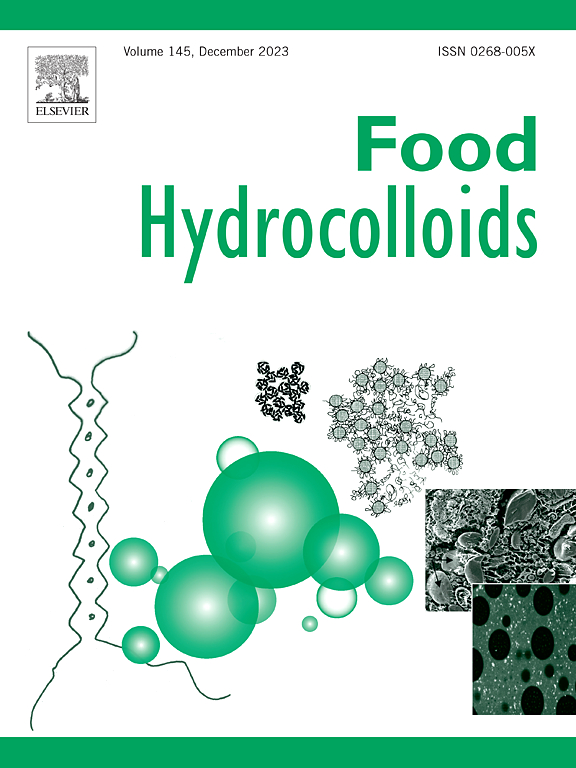热可逆/热不可逆凝乳剂增强了含转谷氨酰胺酶的肉糊在热处理前后的流变行为和胶凝特性
IF 11
1区 农林科学
Q1 CHEMISTRY, APPLIED
引用次数: 0
摘要
本研究考察了转谷氨酰胺酶(TG)和热可逆凝乳酶(TRC)或热不可逆凝乳酶(TIRC)对热处理前后肉制品流变行为、胶凝性能和微观结构的联合影响。结果表明,与单独使用TG相比,TRC/TIRC和TG联合使用可以提高生肉糊的表观粘度,降低其蠕变恢复顺应性。同时,TRC/TIRC和TG可以改善肉糊的粘弹性,促进加热过程中形成坚固的凝胶网络结构,这一点可以通过温度扫描分析得到证实。此外,与对照组相比,TG + trc - 0.5%组和TG + tirc - 0.5%组的熟肉面糊硬度分别从134.92 g和158.69 g显著提高到165.08 g,回弹性分别从84.62 g和113.51 g显著提高(P <;0.05)。此外,TRC和TIRC均能促进熟肉面糊中凝胶网络结构的形成,使面糊的孔隙尺寸分别比对照组减小1.29 μm和1.05 μm。因此,我们的研究结果发现,TRC/TIRC和TG的结合可以改善肉糊的流变行为,促进具有优越胶凝性能的乳化肉制品的开发。本研究为TRC/TIRC联合TG在肉制品中的潜在应用提供了理论基础。本文章由计算机程序翻译,如有差异,请以英文原文为准。

Thermo-reversible/thermo-irreversible curdlan enhanced rheological behaviours and gelling properties of meat batters containing transglutaminase before and after thermal treatment
This study investigated combined effects of transglutaminase (TG) and thermo-reversible curdlan (TRC) or thermo-irreversible curdlan (TIRC) on the rheological behaviours, gelling properties and microstructures of meat batters before and after thermal treatment. The results revealed that compared to TG alone, the combination of TRC/TIRC and TG could increase the apparent viscosity and decrease the creep-recovery compliance of uncooked meat batters. Meanwhile, TRC/TIRC and TG could improve the viscoelasticity of meat batters, facilitating the development of a robust gel network structure during heating process, which can be confirmed by the temperature sweep analysis. Moreover, when compared with the control group, the hardness of cooked meat batters significantly increased from 134.92 g to 165.08 g in the TG + TRC-0.5 % group and to 158.69 g in the TG + TIRC-0.5 % group, while resilience increased from 84.62 g to 122.90 g and 113.51 g, respectively (P < 0.05). Furthermore, both TRC and TIRC promoted the formation of a more compact and denser gel network structure in cooked meat batters, reducing pore size by 1.29 μm and 1.05 μm, respectively, compared to the control group. Therefore, our results found that the combination of TRC/TIRC and TG could improve the rheological behaviours of meat batters and facilitate the development of emulsified meat products with superior gelling properties. This study provided a theoretical foundation for the potential application of TRC/TIRC combined with TG in meat products.
求助全文
通过发布文献求助,成功后即可免费获取论文全文。
去求助
来源期刊

Food Hydrocolloids
工程技术-食品科技
CiteScore
19.90
自引率
14.00%
发文量
871
审稿时长
37 days
期刊介绍:
Food Hydrocolloids publishes original and innovative research focused on the characterization, functional properties, and applications of hydrocolloid materials used in food products. These hydrocolloids, defined as polysaccharides and proteins of commercial importance, are added to control aspects such as texture, stability, rheology, and sensory properties. The research's primary emphasis should be on the hydrocolloids themselves, with thorough descriptions of their source, nature, and physicochemical characteristics. Manuscripts are expected to clearly outline specific aims and objectives, include a fundamental discussion of research findings at the molecular level, and address the significance of the results. Studies on hydrocolloids in complex formulations should concentrate on their overall properties and mechanisms of action, while simple formulation development studies may not be considered for publication.
The main areas of interest are:
-Chemical and physicochemical characterisation
Thermal properties including glass transitions and conformational changes-
Rheological properties including viscosity, viscoelastic properties and gelation behaviour-
The influence on organoleptic properties-
Interfacial properties including stabilisation of dispersions, emulsions and foams-
Film forming properties with application to edible films and active packaging-
Encapsulation and controlled release of active compounds-
The influence on health including their role as dietary fibre-
Manipulation of hydrocolloid structure and functionality through chemical, biochemical and physical processes-
New hydrocolloids and hydrocolloid sources of commercial potential.
The Journal also publishes Review articles that provide an overview of the latest developments in topics of specific interest to researchers in this field of activity.
 求助内容:
求助内容: 应助结果提醒方式:
应助结果提醒方式:


